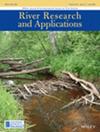与受管制河流中鱼类繁殖有关的环境因素
IF 1.9
4区 环境科学与生态学
Q4 ENVIRONMENTAL SCIENCES
引用次数: 0
摘要
人类对河流进行了大规模改造,以适应人类活动的需要。水坝改变了河流的流量和温度调节,这对荷塘鱼类的繁殖非常重要。然而,目前还缺乏对河流中鱼类产量与环境条件相关性的评估,但需要这种评估来指导试验性环境流量。我们评估了水温和排水量对鲶科(Catostomidae)、鲤科(Sciaenidae)和鲫科(Clupeidae)幼鱼产量的影响,为环境流量管理提供参考。在得梅因河纳入试验性环境流量之前(2014-2015 年)和之后(2021-2022 年),我们从 4 月到 6 月对得梅因河和爱荷华河的鱼类浮游生物进行了采样。我们使用一个障碍模型来评估水温、排水量和排水量变化对幼虫存在(逻辑回归)和密度(线性回归)的影响。一旦水温超过 15°C,就会捕获 Catostomidae 幼体;当水温超过 18°C 时,就会出现 Sciaenidae 幼体;而当水温超过 20°C 时,就会出现 Clupeidae 幼体。幼虫 Sciaenidae 和 Clupeidae 出现的概率随排水量的变化而增加,而密度则与排水量和排水量的变化呈正相关。Sciaenidae 和 Catostomidae 幼虫出现的概率随水温升高而增加。水温与排水量之间的相互作用影响了褐鲤科和鲶科的密度。在水温较高时,Clupeidae 出现的概率随排水量增加而增加。在水温较低(13°C)时,Catostomidae的密度随排水量的增加而增加,而在水温较高(25°C)时,则随排水量的增加而减少。我们的研究结果提供了有关排水量、排水量变化和水温对人类活动改变的河流中幼鱼生产的影响的信息,可用于指导环境流量管理。本文章由计算机程序翻译,如有差异,请以英文原文为准。
Environmental Factors Associated With Fish Reproduction in Regulated Rivers
Humans have extensively altered rivers to accommodate anthropogenic uses. Dams modify river flow and temperature regimes important for lotic fish reproduction. Yet, assessments of fish production in relation to environmental conditions in regulated rivers are lacking but are needed to guide experimental environmental flows. We evaluated the effects of water temperature and discharge on larval Catostomidae, Sciaenidae, and Clupeidae production to inform environmental flow management. We sampled ichthyoplankton from April through June on the Des Moines and Iowa rivers prior to (2014–2015) and after (2021–2022) an experimental environmental flow was incorporated on the Des Moines River. We used a hurdle model to assess the effects of water temperature, discharge, and discharge variation on larval presence (logistic regression) and density (linear regression). Larval Catostomidae were captured once water temperatures exceeded 15°C, Sciaenidae appeared when water temperature surpassed 18°C, while Clupeidae appeared when water temperature exceeded 20°C. The probability of larval Sciaenidae and Clupeidae presence increased with discharge variation while densities were both positively associated with discharge and discharge variation. The probability of Sciaenidae and Catostomidae larval presence increased with water temperature. Interactions between water temperature and discharge influenced Clupeidae presence and Catostomidae density. The probability of Clupeidae presence increased with discharge at warmer water temperatures. Catostomidae densities increased with discharge at cool water temperature (13°C) and decreased with discharge at warm (25°C) temperatures. Our results provide information about the effects of discharge, discharge variation, and water temperature driving larval fish production in anthropogenically altered rivers to guide environmental flow management.
求助全文
通过发布文献求助,成功后即可免费获取论文全文。
去求助
来源期刊

River Research and Applications
环境科学-环境科学
CiteScore
4.60
自引率
9.10%
发文量
158
审稿时长
6 months
期刊介绍:
River Research and Applications , previously published as Regulated Rivers: Research and Management (1987-2001), is an international journal dedicated to the promotion of basic and applied scientific research on rivers. The journal publishes original scientific and technical papers on biological, ecological, geomorphological, hydrological, engineering and geographical aspects related to rivers in both the developed and developing world. Papers showing how basic studies and new science can be of use in applied problems associated with river management, regulation and restoration are encouraged as is interdisciplinary research concerned directly or indirectly with river management problems.
 求助内容:
求助内容: 应助结果提醒方式:
应助结果提醒方式:


